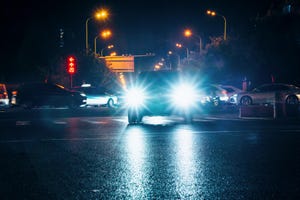
Our wellness advice is expert-vetted. Our top picks are based on our editors’ independent research, analysis, and hands-on testing. If you buy through our links, we may get a commission. Reviews ethics statement
Bright headlights, eye fatigue and bad visibility crop up after dark. These are my tips for staying safe while driving at night.
Driving at night is more dangerous than any other time due to a variety of factors. Whether you’re dealing with glare, fighting with your astigmatism, or dodging deer on the road, there are risks that can put you in danger if you’re not careful.
I’ve learned that driving at night takes extra focus and a few added precautions to stay safe. Whether it’s adjusting how I use my headlights or being more alert on back roads, there are some simple steps that make a big difference when visibility drops.
Many newer vehicles have brighter headlights, causing more glare and afterimages while destroying your night vision. Overly bright LED bulbs and laser emitters can make driving more disorienting than ever. Older drivers and anyone with vision problems such as astigmatism, glaucoma or near-sightedness may also have a harder time seeing on the road because their vision is compromised.
While these problems can affect anyone, there is some good news. Cleaning your windshield and taking advantage of high beams can provide a safer driving experience at night. We’ve collected nine of the best tips to keep you safe, whether you’re driving home from work at dusk or you plan to drive through the night on your next road trip.
9 tips for safer driving at night
Here are a few simple ways to reduce vision problems when driving after dark.
Keep your windshield clean
Glare can increase when your windshield is dirty, as dirt disperses light. Certain treatments, like rain repellent, can also increase glare on your windshield at night. Keep your windshield as clear as possible to reduce glare and help visibility. AAA says a dirty windshield can also limit or obstruct your field of vision, and it recommends cleaning your windshield at least once a week.
Keep your headlights clean
The Mayo Clinic says you can also help increase visibility by ensuring your headlights are free from dirt and debris. Checking for clean headlights is especially important if you live in a dusty region or are in an area where hitting bugs is common.
Use high beams when needed
Be sure to use your high beams on rural roads near forests or fields and, as the National Safety Council recommends, on longer or wider stretches of road. High beams can help you see deer in these instances, but avoid using high beams in rain or fog, as it can reduce visibility. Turn off high beams when going up hills or around bends to avoid shining high beams other drivers’ eyes.
Avoid looking at headlights
It may be instinctive to look directly at a flash of oncoming headlights coming over the hill or around a corner but practice averting your gaze. Looking into bright headlights can temporarily impair your vision and may also leave afterimages, making it harder to see once the vehicle has passed.
Check headlight alignment
The Mayo Clinic also recommends working with your mechanic to ensure headlights are correctly aimed. Wear and tear on your car can cause misalignment and some cars are manufactured with misaligned headlights. US laws don’t require manufacturers to test alignment after the headlights are installed, according to NBC News. The result can be devastating glare for other nighttime drivers plus reduced visibility for you.
Dim your interior car lights
Interior lights should always be off or dimmed when driving at night. They make your eyes more used to light, which can reduce your night vision (our eyes typically take a few minutes to adjust to darkness). If your interior lights are on to help you or a passenger) see something inside your vehicle, it may add to the existing distractions. Interior lights are also one more light source to reflect off your windshield.
Keep your eyeglasses clean
Like dirt on a windshield, smudges on your glasses can disperse light and add to glare problems. Clean your eyewear properly, using a cloth made for eyeglasses, warm water or moisturizer-free mild dish soap, according to Heartland Optical. Wiping your glasses on your shirt may be a common practice but it can also introduce dirt and scratch lenses, obscuring vision further.
Read more: Best Places to Buy Eyeglasses Online
Wear the right eyeglasses
Keep up on optometrist appointments so your doctor can confirm you’re wearing the correct prescription. Also, you can look into antireflective lenses, which have a coating that decreases reflective light. Avoid eyeglass styles that obstruct peripheral vision.
Other options include night driving glasses, which usually have yellow lenses designed to reduce glare from headlights. But be sure to talk to your doctor before using them. Some professionals think they could make your night vision worse instead of better.
Read more: Are You Squinting? Time to Get Your Vision Checked
Keep yourself alert for driving
Even small time changes can leave us feeling jet-lagged. Daylight saving time can throw off your circadian rhythm (that internal clock that tells you when to go to bed and when to stay up), according to Northwestern Medicine, and tiredness can lead to blurred vision. Adjusting to the end of daylight saving time can help you be more alert for driving. Check out our guide on how to recalibrate your internal alarm clock.
The information contained in this article is for educational and informational purposes only and is not intended as health or medical advice. Always consult a physician or other qualified health provider regarding any questions you may have about a medical condition or health objectives.
